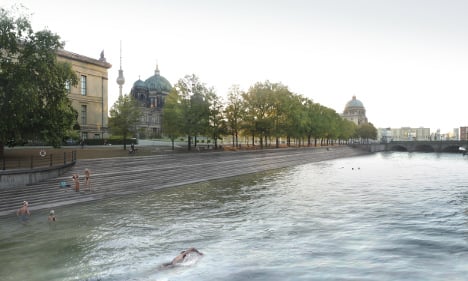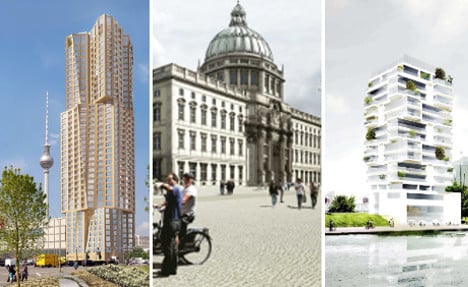For the last 25 years, Berlin has been too small.
The government predicted in 1991 the city's population would hit six million by 2005. Five years later, it lowered its prediction to 4.7 million by 2010.
Today, just over 3.4 million people live here and the Bertelsmann Foundation think-tank expects Berlin's population to reach 3.6 million by 2020.
Yet despite slower population growth than predicted, Berlin has struggled with some of its infrastructure and major development projects.
After 25 years in which "their" Berlin was transformed from the socialist GDR's capital into a favourite destination for tourists, start-ups and real estate investors, some in the eastern half of the city have had enough and are wary of more change.
The most recent riot in June in Rigaer Straße, in the Friedrichshain area of the city, left more than two dozen people injured. "Fight gentrification, stop evictions," exhorted a banner from one squat on the street.
East Side Gallery
Maik Uwe Hinkel learned last year about some of the difficulties developers can face in East Berlin with his luxury apartment project "Living Levels".
The building site sits between the Spree river and the East Side Gallery – a 1.3km long section of the Berlin Wall that features paintings by artists from around the world.
When Hinkel tore down the first Wall segments to allow access to the site for the 60 flats to be built, thousands took to the streets to protest, among them former Baywatch star David Hasselhoff who performed at the Berlin Wall in 1989.
The investor's reported past as a Stasi agent became front-page news. Berlin mayor Klaus Wowereit became cooler about the project and local authorities, who had given Hinkel permission in the first place, loudly complained about the plans.
Despite the uproar, there is a six-metre wide gap in the East Side Gallery today, and "Living Levels" is set to be completed next year.

After his experiences last year, his office told The Local that Hinkel no longer talks to the media.
But the protests did effectively halt progress on a plot next door, where another property investor, Alon Mekel, wants to build a hotel.
Mekel has planning permission from Wowereit's city government but needs the approval of the local district government as well.
Local politicians, however, oppose the project and want to buy back the land – but with city funds because the district can’t afford it.
The Mekel hotel project would widen an existing gap in the East Side Gallery from five metres to 11 metres to provide access point for the luxury flats, the proposed hotel and a public river promenade.
‘Brommybrücke’
The widened gap in the Wall would also allow access to a pedestrian bridge over the Spree connecting the Kreuzberg and Friedrichshain districts.
The restoration of the "Brommybrücke," which was destroyed in World War II, is favoured by the city and both districts, but all three say they cannot pay for it.

Talks have been going on for more than a decade but the bridge is unlikely to be built before the 2020, a city official said in December.
Alexanderplatz
Plenty of talk also surrounds the future of the iconic Alexanderplatz.
It is the place where Berlin's grand post-reunification visions and today's less boastful reality are further apart than anywhere else in the city.
In 1993, architect Hans Kollhoff developed a masterplan that – in the spirit of a city expected to boom soon – authorized ten skyscrapers up to 150 metres high. That boom failed to materialize, as did the skyscrapers.
Instead, existing buildings were renovated or smaller ones built around the square.
But plans are afoot to start building skyscrapers on Alexanderplatz again.

Two decades after Kollhoff's master plan, investors are getting ready to change Alexanderplatz's skyline. Plans for one tower, designed by star Canadian-American architect Frank Gehry, were presented earlier this year.
And Russian investors want to build a 150-metre high-rise next to shopping mall "Alexa". Local authorities have issued a preliminary construction permit for the project.
City Palace
The one large flagship project without delays or cost overruns in Berlin, for the moment, is the Berliner Stadtschloss (City Palace).
Once the main residence of Germany's emperors, it will soon house Berlin's collections of non-European art and culture, a science museum and books from the state library's catalogue.
The federal government is paying €590 million of the costs to build the palace, but another €80 million needs to be raised through private donations.
Currently, the project is €50 million short, but supporters say they will meet the target before the palace is scheduled to open in 2019.

The trouble-plagued "Monument to Freedom and Unity" across the street from the palace could also be completed by then.
The monument, a giant see-saw, will stand on the platform of the former national Kaiser Wilhelm monument, which East Germany's socialist rulers demolished in 1950.
Supporters initially wanted to inaugurate the unity monument in November to commemorate the fall of the Berlin Wall 25 years ago. Now they aim for October 2015, a quarter century after the eastern and western Germany reunited.
But given the long list of questions that surround the project, that deadline could be missed, too.

Among the problems facing the project are bats living in the area that are protected and need to be resettled as well as accessibility for disabled people.
The city and the federal governments are blaming each other for the lack of answers and related delays.
Just swim?
Berliners themselves are more excited about a potential new attraction in the historic centre.
"Flussbad Berlin" wants to make it possible to swim in the Kupfergraben, a small canal running parallel to the Spree river.
The Spree's water, for decades too contaminated for swimmers, could be cleaned thanks to an innovative filter technology installed upstream.

The project would be far less grandiose than others officials are focused on at the moment, such as the long overdue Berlin Brandenburg Airport, which was supposed to open in 2012 or the talk about a Berlin bid for the 2024 or 2028 Olympic Games.
But for a city tired of and too broke for large-scale developments with their predictable delays and growing price tags, a riverside swimming pool might be about the right size.
For the last 25 years, Berlin has been hyped as everything from Europe's next commercial hub to the world's hippest tourist destination. Maybe all Berliners really want is to splash around in the Spree or fly a kite at the former airport in Tempelhof.


 Please whitelist us to continue reading.
Please whitelist us to continue reading.
Member comments